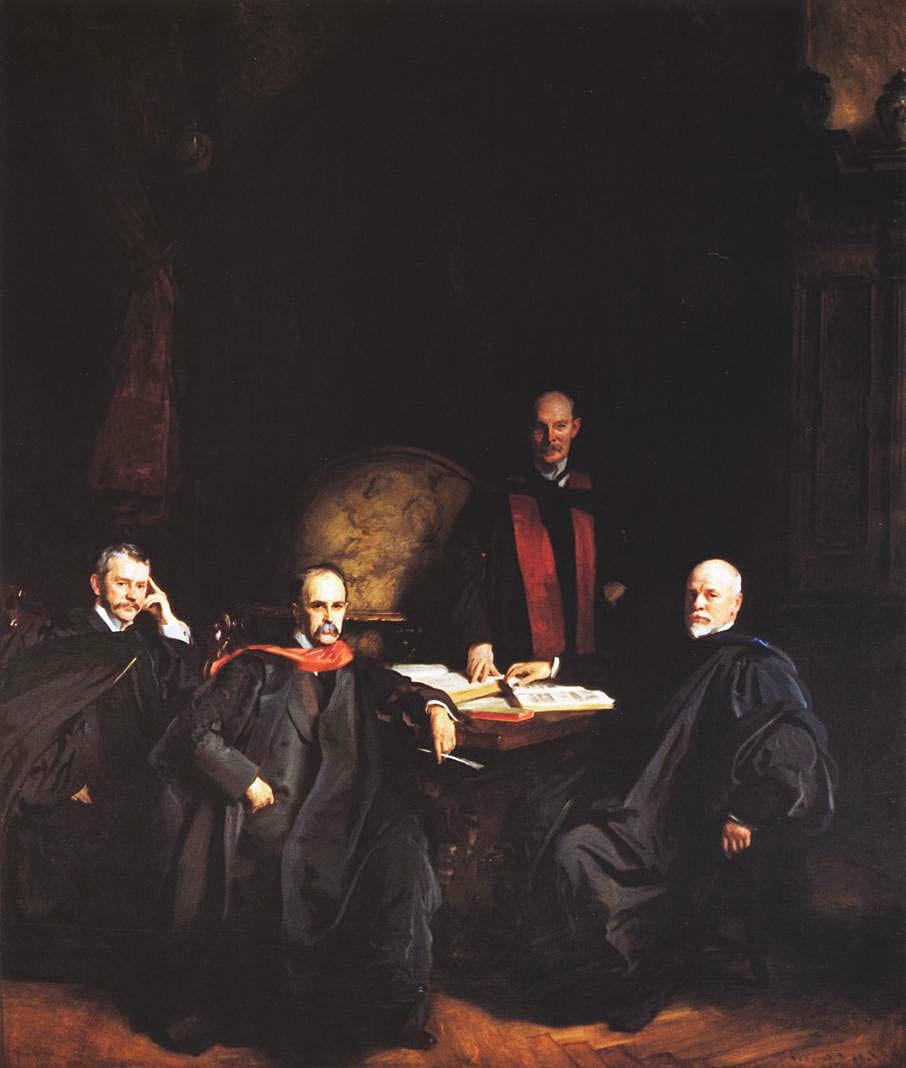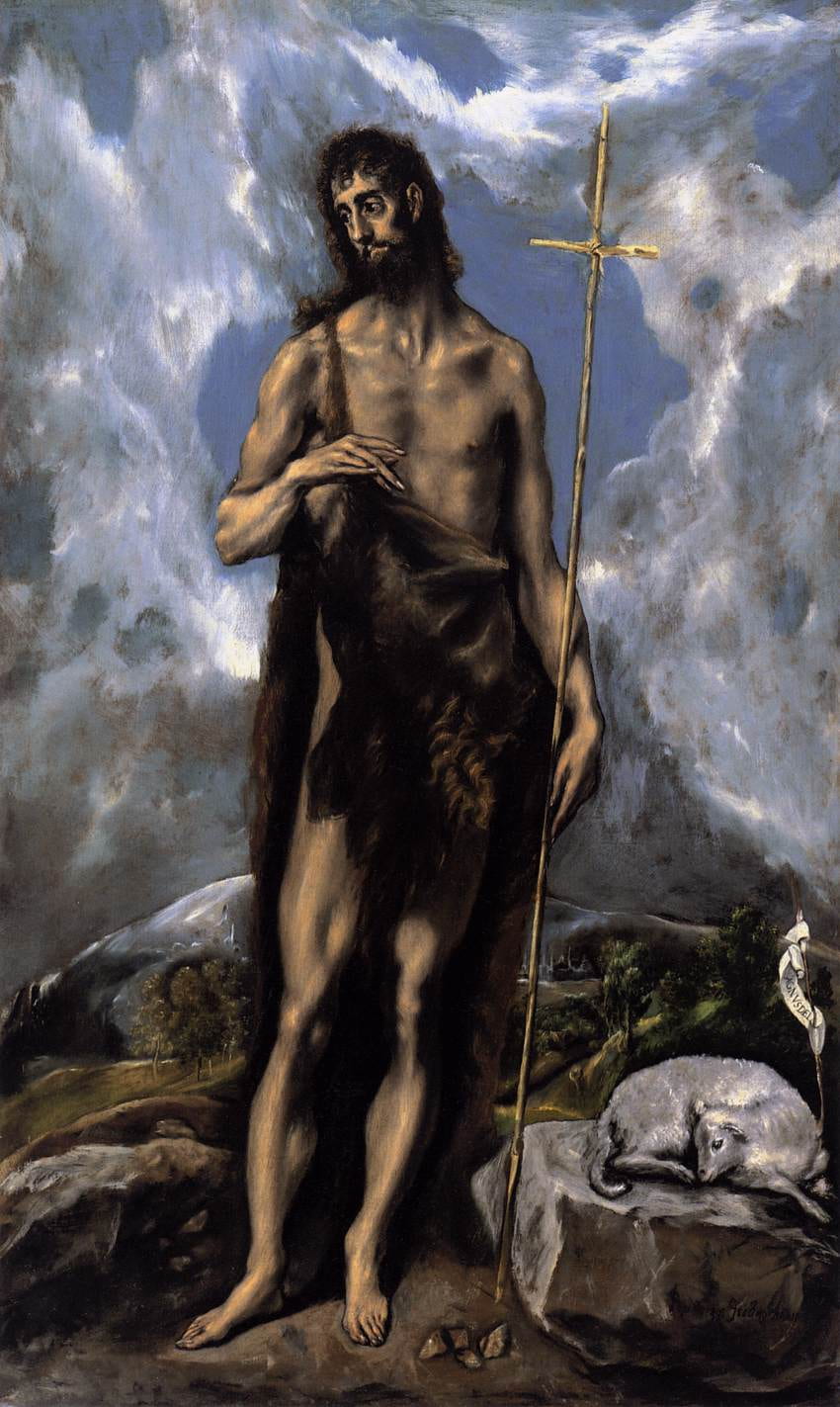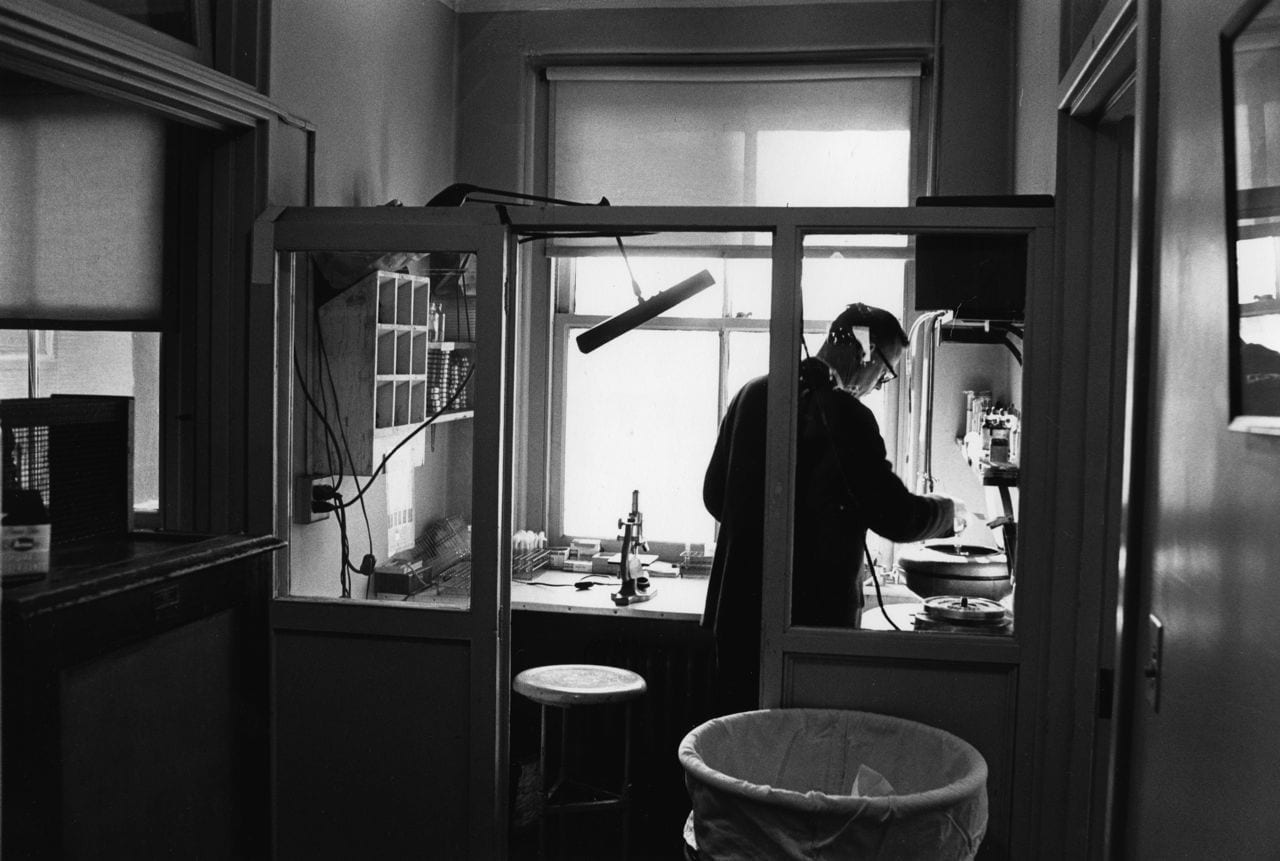By Editor Spencer J. Weinreich
Four enormous, dead doctors were present at the opening of the 2017 Joint Atlantic Seminar in the History of Medicine. Convened in Johns Hopkins University’s Welch Medical Library, the room was dominated by a canvas of mammoth proportions, a group portrait by John Singer Sargent of the four founders of Johns Hopkins Hospital. Dr. William Welch, known in his lifetime as “the dean of American medicine” (and the library’s namesake). Dr. William Halsted, “the father of modern surgery.” Dr. Sir William Osler, “the father of modern medicine.” And Dr. Howard Kelly, who established the modern field of gynecology.

John Singer Sargent, Professors Welch, Halsted, Osler, and Kelly (1905)
Beneath the gazes of this august quartet, graduate students and faculty from across the United States and the United Kingdom gathered for the fifteenth iteration of the Seminar. This year, the program’s theme was “Truth, Power, and Objectivity,” explored in thirteen papers ranging from medical testimony before the Goan Inquisition to the mental impact of First World War bombing raids, from Booker T. Washington’s National Negro Health Week to the emergence of Chinese traditional medicine. It would not do justice to the papers or their authors to cover them all in a post; instead I shall concentrate on the two opening sessions: the keynote lecture by Mary E. Fissell and a faculty panel with Nathaniel Comfort, Gianna Pomata, and Graham Mooney (all of Johns Hopkins University).
I confess to some surprise at the title of Fissell’s talk, “Aristotle’s Masterpiece and the Re-Making of Kinship, 1820–1860.” Fissell is known as an early modernist, her major publications exploring gender, reproduction, and medicine in seventeenth- and eighteenth-century England. Her current project, however, is a cultural history of Aristotle’s Masterpiece, a book on sexuality and childbirth first published in 1684 and still being sold in London sex shops in the 1930s. The Masterpiece was distinguished by its discussion of the sexual act itself, and its consideration (and copious illustrations) of so-called “monstrous births.” It was, in Fissell’s words, a “howling success,” seeing an average of one edition a year for 250 years, on both sides of the Atlantic.
It should be explained that there is very little Aristotle in Aristotle’s Masterpiece. In early modern Europe, the Greek philosopher was regarded as the classical authority on childbirth and sex, and so offered a suitably distinguished peg on which to hang the text. This allowed for a neat trick of bibliography: when the Masterpiece was bound together with other (spurious) works, like Aristotle’s Problems, the spine might be stamped with the innocuous (indeed impressive) title “Aristotle’s Works.”

El Greco, John the Baptist (c.1600)
At the heart of Aristotle’s Masterpiece, Fissell argued, was genealogy: how reproduction—“generation,” in early modern terms—occurred and how the traits of parents related to those of their offspring. This genealogy is unstable, the transmission of traits open to influences of all kinds, notably the “maternal imagination.” The birth of a baby covered in hair, for example, could be explained by the pregnant mother’s devotion to an image of John the Baptist clad in skins. Fissell brilliantly drew out the subversive possibilities of the Masterpiece, as when it “advised” women that adultery might be hidden by imagining one’s husband during the sex act, thus ensuring that the child would look like him. Central though family resemblance is to reproduction, it is “a vexed sign,” with “several jokers in every deck,” because women’s bodies are mysterious and have the power to disrupt lineage.
Fissell principally considered the Masterpiece’s fortunes in the mid-nineteenth-century Anglophone world, as the unstable generation it depicted clashed with contemporary assumptions about heredity. Here she framed her efforts as a “footnote” to Charles Rosenberg’s seminal essay, “The Bitter Fruit: Heredity, Disease, and Social Thought in Nineteenth-Century America,” which traced how discourses of heredity pervaded all branches of science and medicine in this period. George Combe’s Constitution of Man (1828), an exposition of the supposedly rigid natural laws governing heredity (with a tilt toward self-discipline and self-improvement), was the fourth-bestselling book of the period (after the Bible, Pilgrim’s Progress, and Robinson Crusoe). Other hereditarian works sketched out the gendered roles of reproduction—what children inherited from their mothers versus from their fathers—and the possibilities for human action (proper parenting, self-control) for modulating genealogy. Wildly popular manuals for courtship and marriage advised young people on the formation of proper unions and the production of healthy children, in terms shot through with racial and class prejudices (though not yet solidified into eugenics as we understand that term).
The fluidity of generation depicted in Aristotle’s Masterpiece became conspicuous against the background of this growing obsession with a law-like heredity. Take the birth of a black child to white parents. The Masterpiece explains that the mother was looking at a painting of a black man at the moment of conception; hereditarian thought identified a black ancestor some five generations back, the telltale trait slowly but inevitably revealing itself. Thus, although the text of the Masterpiece did not change much over its long career, its profile changed dramatically, because of the shifting bibliographic contexts in which it moved.
In the mid-nineteenth century, the contrasting worldviews of the Masterpiece and the marriage manuals spoke to the forms of familial life prevalent at different social strata. The more chaotic picture of the Masterpiece reflected the daily life of the working class, characterized by “contingent formations,” children born out of wedlock, wife sales, abandonment, and other kinds of “marital nonconformity.” The marriage manuals addressed themselves to upper-middle-class families, but did so in a distinctly aspirational mode. They warned, for example, against marrying cousins, precisely at a moment when well-to-do families were “kinship hot,” in David Warren Sabean’s words, favoring serial intermarriage among a few allied clans. This was a period, Fissell explained, in which “who and what counted as family was much more complex” and “contested.” The ambiguity—and power—of this issue manifested in almost every sphere, from the shifting guidelines for census-takers on how a “family” was defined, to novels centered on complex kinship networks, such as John Lang’s Will He Marry Her? (1858), to the flood of polemical literature surrounding a proposed law forbidding a man to marry his deceased wife’s sister—a debate involving many more people than could possibly have been affected by the legislation.
After a rich question-and-answer session, we shifted to the faculty panel, with Professors Comfort, Pomata, and Mooney asked to reflect on the theme of “Truth, Power, and Objectivity.” Comfort, a scholar of modern biology, began by discussing his work with oral histories—“creating a primary source as you go, and in most branches of history that’s considered cheating.” Here perfect objectivity is not necessarily helpful: “when you make yourself emotional availability to your subjects […] you can actually gain their trust in a way that you can’t otherwise.” Equally, Comfort encouraged the embrace of sources’ unreliability, suggesting that unreliability might itself be a source—the more unreliable a narrative is, the more interesting and the more indicative of something meant it becomes. He closed with the observation that different audiences required different approaches to history and to history-writing—it is not simply a question of tone or language, but of what kind of bond the scholar seeks to form.
Professor Pomata, a scholar of early modern medicine, insisted that moments of personal contact between scholar and subject were not the exclusive preserve of the modern historian: the same connections are possible, if in a more mediated fashion, for those working on earlier periods. In this interaction, respect is of the utmost importance. Pomata quoted a line from W. B. Yeats’s “He wishes for the Cloths of Heaven”:
I have spread my dreams under your feet;
Tread softly because you tread on my dreams.
As a historian of public health—which he characterized as an activist discipline—Mooney declared, “I’m not really interested in objectivity. […] I’m angry about what I see.” He spoke compellingly about the vital importance of that emotion, properly channeled toward productive ends. The historian possesses power: not simply as the person setting the terms of inquiry, but as a member of privileged institutions. In consequence, he called on scholars to undermine their own power, to make themselves uncomfortable.
The panel was intended to be open-ended and interactive, so these brief remarks quickly segued into questions from the floor. Asked about the relationship between scholarship and activism, Mooney insisted that passion, even anger, are essential, because they drive the scholar into the places where activism is needed—and cautioned that it is ultimately impossible to be the dispassionate observer we (think we) wish to be. With beautiful understatement, Pomata explained that she went to college in 1968, when “a lot was happening in the world.” Consequently, she conceived of scholarship as having to have some political meaning. Working on women’s history in the early 1970s, “just to do the scholarship was an activist task.” Privileging “honesty” over “objectivity,” she insisted that “scholarship—honest scholarship—and activism go together.” Comfort echoed much of this favorable account of activism, but noted that some venues are more appropriate for activism than others, and that there are different ways of being an activist.
Dealing with the horrific—eugenics was the example offered—requires, Mooney argued, both the rigor of a critical method and sensitive emotional work. Further, all three panelists emphasized crafting, and speaking in, one’s own voice, eschewing the temptation to imitate more prominent scholars and embracing the first person (and the subjectivity it marks). Voice, Comfort noted, isn’t natural, but something honed, and both he and Pomata recommended literature as an essential tool in this regard.
Throughout, the three panelists concurred in urging collaborative, interdisciplinary work, founded upon respect for other knowledges and humility—which, Comfort insightfully observed, is born of confidence in one’s own abilities. Asking the right questions is crucial, the key to unlocking the stories of the oppressed and marginalized within sources created by those in power. Visual sources have the potential to express things inexpressible in words—Comfort cited a photograph that wonderfully captured the shy, retiring nature of Dr. Barton Childs—but must be used, not mere illustrations. The question about visual sources was the last of the evening, and Professor Pomata had the last word. Her final comment offers the perfect summation of the creativity, dedication, and intellectual ferment on display in Baltimore that weekend: “we are artists, don’t forget that.”




Leave a Reply